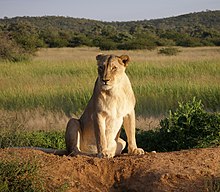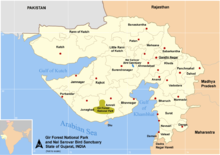Panthera leo
| Lion Temporal range: Late Pliocene–Recent |
|
|---|---|
 |
|
| A male Southwest African lion | |
 |
|
| A female (lioness) | |
| Scientific classification | |
| Kingdom: | Animalia |
| Phylum: | Chordata |
| Class: | Mammalia |
| Order: | Carnivora |
| Family: | Felidae |
| Genus: | Panthera |
| Species: | P. leo |
| Binomial name | |
|
Panthera leo (Linnaeus, 1758) |
|
| Subspecies | |
|
Panthera leo subspecies
P. l. azandica |
|
 |
|
| Distribution of Panthera leo in Africa and Eurasia, in the past and present. | |
 |
|
| Distribution of lions in India: The Gir Forest and surrounding areas in Kathiawar Peninsula, Gujarat comprise the last natural range of more than 500 wild Asiatic lions. There are plans to reintroduce some lions to Kuno Wildlife Sanctuary in neighbouring Madhya Pradesh. | |
| Synonyms | |
|
Linnaeus, 1758 |
|
P. l. azandica
P. l. bleyenberghi
P. l. hollisteri
P. l. kamptzi
P. l. krugeri
P. l. leo
P. l. maculatus
P. l. nubica
P. l. persica
P. l. senegalensis
P. l. verneyi
P. l. nyanzae
P. l. roosevelti
P. l. somaliensis![]() P. l. atrox
P. l. atrox![]() P. l. europaea
P. l. europaea![]() P. l. melanochaita
P. l. melanochaita![]() P. l. sinhaleyus
P. l. sinhaleyus![]() P. l. spelaea
P. l. spelaea
The lion (Panthera leo) is one of the big cats in the genus Panthera and a member of the family Felidae. The commonly used term African lion collectively denotes the several subspecies in Africa. With some males exceeding 250 kg (550 lb) in weight, it is the second-largest living cat after the tiger, barring hybrids like the liger. Wild lions currently exist in sub-Saharan Africa and in India (where an endangered remnant population resides in and around Gir Forest National Park). In ancient historic times, their range was in most of Africa, including North Africa, and across Eurasia from Greece and southeastern Europe to India. In the late , about 10,000 years ago, the lion was the most widespread large land mammal after humans: Panthera leo spelaea lived in northern and western Europe and Panthera leo atrox lived in the Americas from the Yukon to Peru. The lion is classified as a vulnerable species by the International Union for Conservation of Nature (IUCN), having seen a major population decline in its African range of 30–50% over two decades during the second half of the twentieth century. Lion populations are untenable outside designated reserves and national parks. Although the cause of the decline is not fully understood, habitat loss and conflicts with humans are the greatest causes of concern. Within Africa, the West African lion population is particularly endangered.
...
Wikipedia

